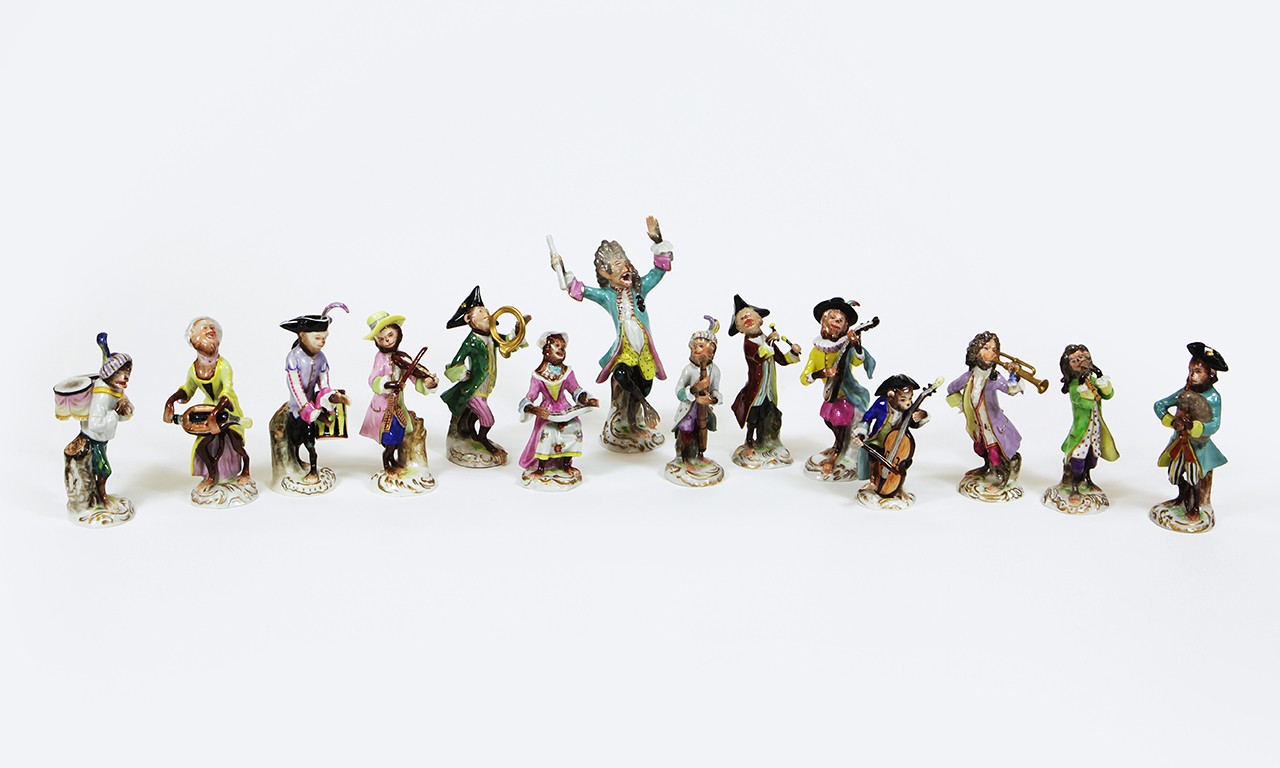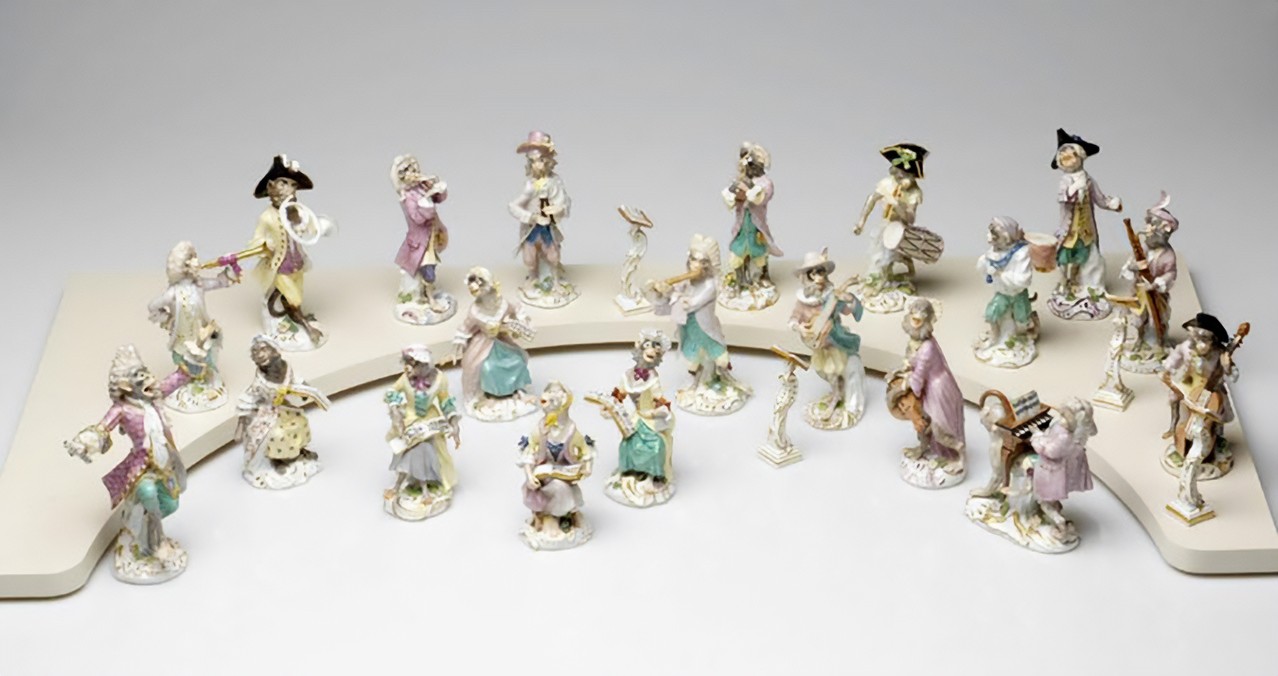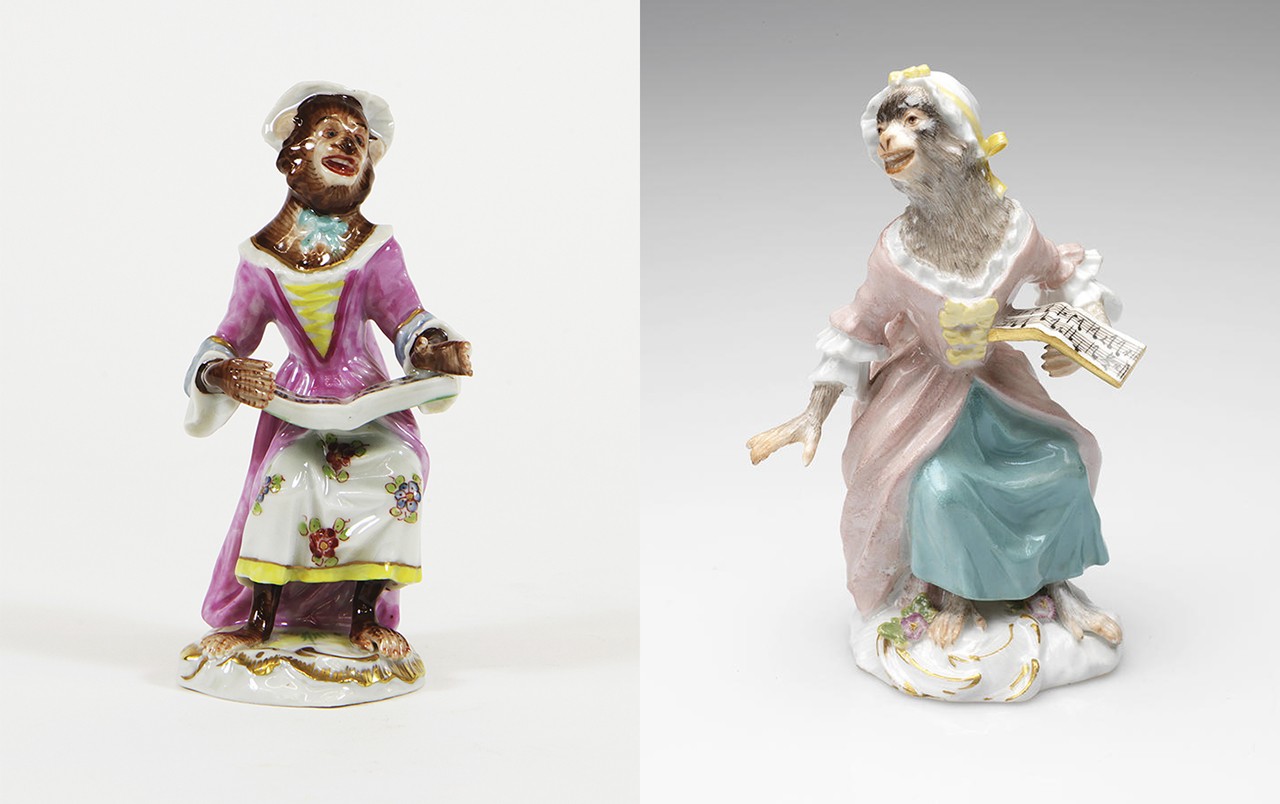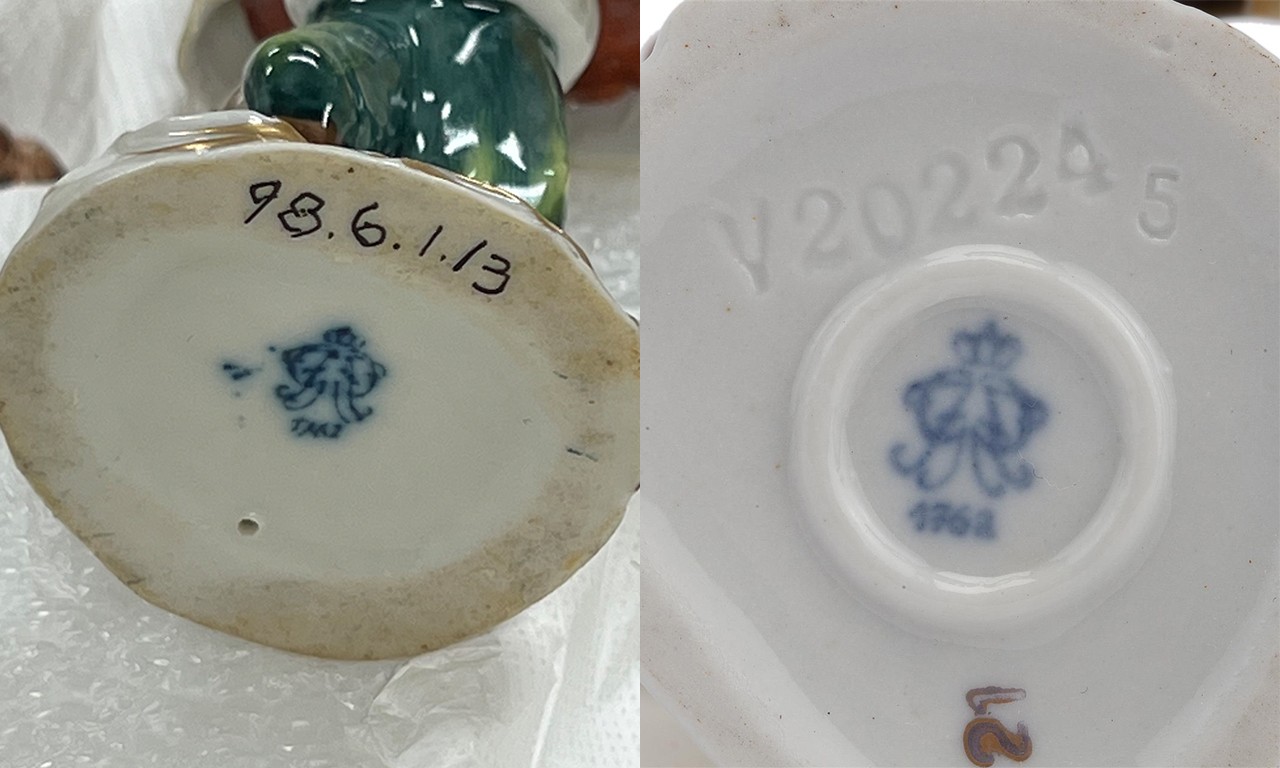 |
Monkey Orchestra (Affenkapelle), early to mid 20th century
Aelteste Volkstedter Porzellanmanufaktur; Rudolstadt, Germany
Porcelain and enamel
98.6.1a-n
Gift of Mr. Randall Balch |
Imitation Game
Monkeys make for lively subjects and, as anyone who has studied a monkey (even if only on social media) will attest, they are remarkably human in many ways, not the least for their tool use and proclivity for mimicry. Perhaps among all the other similarities between primates and humans, it is imitation that so often makes them feel like kindred spirits to us. This post, which looks at an orchestra of 14 instrument- and score-toting porcelain monkeys formerly misattributed to the Meissen Porcelain Manufactory, is also at its core about mimicry, though in this case the borrowing of an idea and a form.
 |
| Meissen Porcelain Manufactory, mid to late 19th century |
Industrial Espionage
Porcelain decorative objects have been popular in Europe since royalty began importing them from China in the 13th century. The hefty price associated with the long journey led many individuals to try to figure out how this valuable and desirable material was made so that it could be replicated more cheaply. Finally, in 1708, Johann Friedrich Böttger was able reproduce what had been done in China and perfect the first European white porcelain. There was an immediate rush to take this new development and build infrastructure so that porcelain could be produced locally. The Meissen Porcelain Manufactory was established in the German town of its namesake and quickly began to produce porcelains that dominated the market.
 |
Tabakskollegium von Affen (Tobacco Club with Monkeys), mid-17th century
Abraham Teniers (Flemish, 1629–1670)
Oil on copper; 9 3/8 x 12 1/8 in.
Collection of the Gemäldegalerie |
Funky Monkey
Creating an orchestra of monkey musicians might seem like a questionable artistic choice, but monkeys tended to be a surefire hit in Europe’s Age of Enlightenment. Anthropomorphized monkeys engaged in silly or mundane—but always thoroughly human—pursuits were one of the most popular subjects in sculpture and painting at the time, particularly in France and Germany. The borrowed term for such creations in English comes from the French singerie and roughly translates to “monkeying around.” Meissen capitalized on and contributed to this trend when their chief modeler Johann Joachim Kändler created the first version of the monkey orchestra, or Affenkapelle in German, in the 1750s. This quirky set of figures quickly became one of Meissen’s most famous products. Among the very highest echelons of society individuals like King Louis XV’s mistresses purchased sets of these simian minstrels.

 |
The Monkey Band (Affenkapelle), c. 1753
Johann Joachim Kändler (German, 1706-1775); Meissen Porcelain Manufactory; Meissen, Germany
Porcelain and enamel
Collection of the Rhode Island School of Design Museum |
Chimp Off the Old Block
Rather than being one of those historic oddities that vanished into the annals of time as carelessly as it had appeared, Meissen’s monkey orchestra lived on. The demand was so great that the set was reissued in the 1760s. The humor and eclectic nature of these monkeys continued to charm consumers and, sensing this market potential, other manufacturers throughout Germany began to create their own versions. Various sets can be attributed to the 19th and 20th centuries. Even today, 21st century consumers continue to be fascinated with the orchestra and a single original Meissen monkey musician can sell for several thousand dollars. For a long time, it was believed that the Bowers monkey orchestra was an original Meissen made by Kändler, but as we now know it was made in the early to mid 20th century in the style of the original.

 |
Monkey Orchestra (Affenkapelle) Singer, early to mid 20th century
Aelteste Volkstedter Porzellanmanufaktur; Rudolstadt, Germany
Porcelain and enamel; 4 x 1 3/4 x 1 3/4 in.
98.6.1g
Gift of Mr. Randall Balch |
The Monkey Band (Affenkapelle) Singer, c. 1753
Johann Joachim Kändler (German, 1706-1775); Meissen Porcelain Manufactory; Meissen, Germany
Porcelain and enamel
Collection of the Rhode Island School of Design Museum |
Baboons and Bassoons
The Bowers’ orchestra consists of 14 monkey musicians. Each figure is attired in bright 18th century Rococo style garments as is characteristic of the original Meissen orchestras. Above are two versions of a singer holding sheet music, on the right is an original Meissen from the Rhode Island School of Design (RISD) Museum. Delicate bows bounce off the form of the bonnet-capped primate, every strand of fur lies exactly as one would expect, and the sheet music shows an actual tune—one which might have had a special significance for the original aristocratic owner. The Bowers figure is still impressive though perhaps more reminiscent of a Washingtonian cryptid in costume than a courtly capuchin. Its details are more fuzzily defined, applied more through painting than sculpture. The patterning of the fur relies mostly on large swaths of dark brown paint. The characters on their pages are just faux filler and not the notes of a tune.

 |
Base of Monkey Orchestra (Affenkapelle) Drummer, early to mid 20th century
Aelteste Volkstedter Porzellanmanufaktur; Rudolstadt, Germany
Porcelain and enamel; 4 1/2 x 2 x 2 in.
98.6.1.1m
Gift of Mr. Randall Balch |
Base of Monkey Orchestra (Affenkapelle) Figure, early to mid 20th century
Aelteste Volkstedter Porzellanmanufaktur; Rudolstadt, Germany
Porcelain and enamel
John Moran Auction |
 |
Near identical example of Monkey Orchestra (Affenkapelle), early to mid 20th century
Aelteste Volkstedter Porzellanmanufaktur; Rudolstadt, Germany
Porcelain and enamel
John Moran Auction |
Seeking Apesolution
The misattribution was given to the Bowers right alongside the object and the correction too came from an external source. The orchestra’s donor identified it as a Meissen Affenkapelle and the designation was further substantiated through an expert’s appraisal. However, this error was not discovered by Bowers staff in the research conducted when the object was donated nor when the object was researched for its original 2016 blog post. In researching a specific element of the original Meissen figures a Dr. Nigel Springthorpe reviewed these pieces and made the determination based off of the maker’s mark that the set was most likely made by the Aelteste Volkstedter Porzellanmanufaktur in Rudolstadt, Germany during a seven-year period between the mark being introduced and the onset of WWII.
Imitation can be a euphemism for forgery in the art world, especially when proper permission is not sought. Still, we can see from this post that it has been imitations that have kept alive an artform that might otherwise have disappeared into all but a few private and museum collections. Even an imitation Affenkapelle is a circus of delights.
Text and images may be under copyright. Please contact Collection Department for permission to use. Information subject to change upon further research.








Comments 2
Good post of Meissen's porcelain, in an incredibly interesting blog with very useful information in our daily work. Thanks and regards from Barcelona. artpironti.com
I have a clock I’m trying to find out more about. It has a monkey orchestra on it with 6 monkeys.May be interested in selling. It’s really dirty, but Im not sure the best way to clean It.